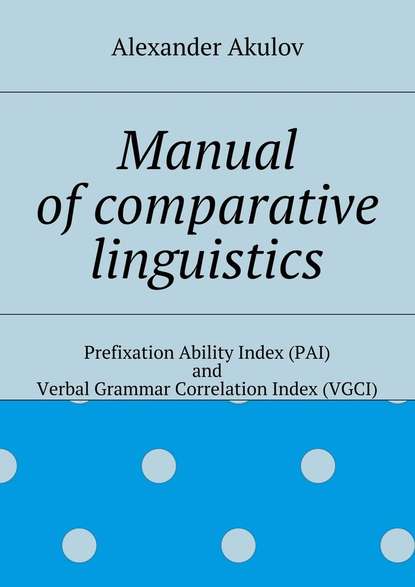По всем вопросам обращайтесь на: info@litportal.ru
(©) 2003-2024.
✖
Manual of comparative linguistics
Настройки чтения
Размер шрифта
Высота строк
Поля
Bunun 0.8 (calculated after De Busser 2009)
Eastern Barito group
Malagasy 0.74 (calculated after Arakin 1963)
2.1.4.2. PAI of languages Indo-European stock
German group
Dutch 0.49 (calculated after Donaldson 1997)
German 0.51 (calculated after Donaldson 2007)
English 0.61 (calculated after Barhkhudarov et al. 2000)
Icelandic 0.63 (calculated after Einarsson 1949)
Slavonic group
Czech 0.52 (calculated after Harkins 1952)
Polish 0.57 (calculated after Swan 2002)
Celtic group
Irish 0.67 (McGonage 2005)
Welsh 0.35 (calculated after King 2015)
Roman group
Latin 0.26 (calculated after Bennet 1913)
Spanish 0.34 (calculated after Kattаn-Ibarra, Pountain 2003)
2.1.4.3. PAI of languages of Afroasiatic stock
Semitic group
Central Semitic subgroup
Arabic (Classical) 0.26 (calculated after Yushmanov 2008)
Phoenician 0.26 (calculated after Shiftman 2010)
Eastern Semitic subgroup
Akkadian (Old Babylonian dialect) 0.2 (calculated after Kaplan 2006)
Egypt group
Coptic (Sahidic dialect) 0.87 (calculated after Elanskaya 2010)
Pic. 3. Diagram representing PAI values of some firmly assembled stocks
2.1.5. PAI of a group/stock
PAI of a group or a stock can be calculated as arithmetical mean and it’s quite precise for rough estimation.
One can probably say that just arithmetic mean is quite rough estimation and in order to estimate PAI in a more precise way it would be better to take values of PAI of particular languages with coefficients that show proximity of particular languages to the ancestor language of the stock. Coefficient of proximity is degree of correlation of grammar systems.
Let’s test this hypothesis and see whether it so.
For instance, in the case of Austronesian it would be somehow like the following:
Malagasy^PAN[9 - PAN means Proto-Austronesian; “^” is sign of grammar/structure correlation] ? 0.5;
Bunun^PAN ? 0.8;
Philippine group^PAN ? 0.7;
Indonesian^PAN ? 0.6;
Cham^PAN ? 0.4;
Polynesian languages^PAN ? 0.5.
Indexes show degree of proximity of languages (grammatical systems). In current case these indexes are not results of any calculations but just approximate speculative estimation of degrees of proximity of modern Austronesian languages with Proto-Austronesian; it is supposed that Formosan languages and so called languages of Philippines type are the closest relatives of PAN among modern Austronesian.
If we take each particular PAI value with corresponding coefficient of proximity we get that PAI of Austronesian is about 0.44.
If we take just arithmetical mean without proximity coefficients we get 0.6.
0.6 is obviously closer to real values of PAI of Austronesian languages than 0.44. Hence thereby it’s possible to state that just arithmetical mean is completely sufficient way to calculate PAI of a group/stock while PAI calculated with use of proximity coefficients gives results that differ seriously from reality.
2.1.6. PAI in diachrony
It can be supposed that PAI doesn’t change much in diachrony.
PAI of Late Classical Chinese is 0.5 (calculated after Pulleyblank 1995).
PAI of Contemporary Mandarin is 0.5. (calculated after Ross, Sheng Ma 2006).
PAI of Early Old Japanese is 0.13 (calculated after Syromyatnikov 2002).
PAI of contemporary Japanese is 0.13 (calculated after Lavrent’yev 2002).
Probably it should be also tested on other examples but even on the material of these examples we can see that PAI of a language is same in different stages of its history.





